 Global| Jan 11 2007
Global| Jan 11 2007MAPI Business Outlook Survey Fell Again
by:Tom Moeller
|in:Economy in Brief
Summary
The 4Q '06 Composite Business Index published by the Manufacturers' Alliance/MAPI fell for the third straight quarter, to 54 from 64 in 3Q '06. The figure was the lowest since early 2002. During the last ten years there has been a 69% [...]
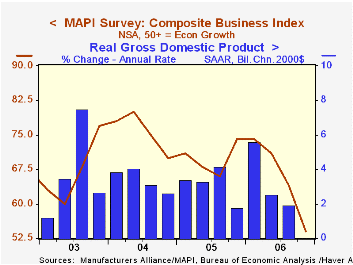
The 4Q '06 Composite Business Index published by the Manufacturers' Alliance/MAPI fell for the third straight quarter, to 54 from 64 in 3Q '06. The figure was the lowest since early 2002.
During the last ten years there has been a 69% correlation between the Composite Index Level and quarterly growth in US factory sector output.
The current orders index dropped sharply to 66, the lowest since 2002 but the 4Q export orders index rose and recouped declines in the prior two quarters. During the last ten years there has been a 59% correlation between the export orders index and quarterly growth in real US exports.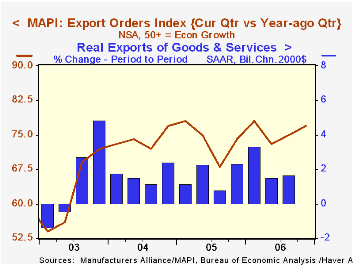
The profit margins index fell sharply to 62 versus an average 65 last year, its lowest level since 2Q '05.Capital spending intentions for the coming year, however, improved. During the last ten years there has been a 75% correlation between the capital spending index a q/q growth in business investment.
The survey of 60 senior financial executives representing a broad range of manufacturing industries reflects the views on current & future business conditions. The business outlook index is a weighted sum of shipments, backlogs, inventories, and profit margin indexes.
For the latest US Business Outlook from the MAPI click here.
U.S. Economic Outlook - Remarks by Michael H. Moskow, President and Chief Executive Officer, Federal Reserve Bank of Chicago are available here.
| Manufacturers' Alliance/MAPI Survey | 4Q '06 | 3Q '06 | 4Q '05 | 2006 | 2005 | 2004 |
|---|---|---|---|---|---|---|
| Composite Business Index | 54 | 64 | 74 | 66 | 70 | 76 |
by Tom Moeller January 11, 2007
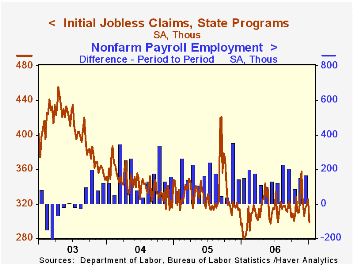
Initial unemployment insurance claims last week reversed all of the increases over the prior three weeks and fell 26,000 to 299,000, the lowest level since July. Consensus expectations had been for a roughly unchanged figure at 325,000.
During the last ten years there has been a (negative) 77% correlation between the level of initial claims and the m/m change in nonfarm payroll employment.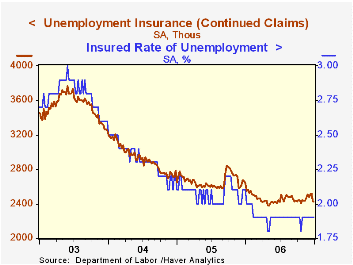
The four-week moving average of initial claims also fell to 314,750 (3.3% y/y).
Continuing claims for unemployment insurance also fell 3,000 and the prior week's sharp decline was deepened to 91,000.
The insured rate of unemployment remained at 1.9% for the seventh consecutive week and equaled the average rate since February.
Will Moderating Growth Reduce Inflation? from the Federal Reserve Bank of San Francisco can be found here.
| Unemployment Insurance (000s) | 01/06/07 | 12/30/06 | Y/Y | 2006 | 2005 | 2004 |
|---|---|---|---|---|---|---|
| Initial Claims | 299 | 325 | 0.3% | 313 | 332 | 343 |
| Continuing Claims | -- | 2,428 | -8.0% | 2,459 | 2,662 | 2,924 |
by Carol Stone January 11, 2007
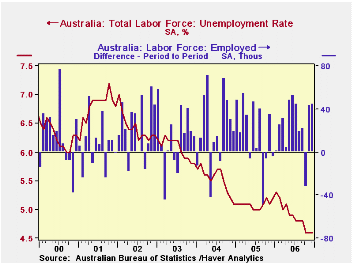
Employment in Australia grew 45,000 in the month of December, about the same as in November and far above the consensus expectation of 15,000 given in one news service forecast survey. This put the year-to-year growth rate at 3.0%.
The number of Australians unemployed rose 2,200 following a 3,800 increase in November. But these small increases still left the total unemployed right at 500,000, among the lowest since the early months of 1990. The resulting unemployment rate remained at 4.6% for a third consecutive month, the lowest in the almost-29-year history of these labor force data.
This labor market performance is impressive as it accompanied a rise in the participation rate from 64.78% to 64.95%, near the all-time high of 65.02% reached in September. [The Bureau of Statistics publishes the participation rate rounded to one decimal place. We calculated the rate from labor force and population series so we could see more precise changes.]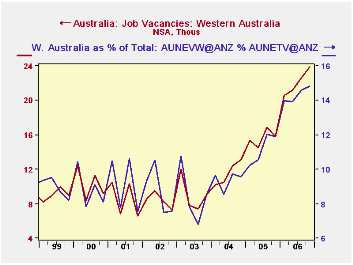
Further, in Q4, separate data reported Wednesday show job vacancies at an all-time high of nearly 164,000, up more than 21% from the year-ago period. as seen in our second graph, much of the strength is in Western Australia -- Perth -- perhaps owing to growing trade in Indian Ocean territories. Queensland also shows gains. The two greatest population centers, New South Wales (Sydney) and Victoria (Melbourne) are seeing a steady number of reported job vacancies.
So the Australian labor market is doing well and, with rising vacancies, perhaps can sustain that track.
These data are contained in Haver's "ANZ" database and in "G10".
| AUSTRALIA (Months Seas Adj) | Dec 2006 | Nov 2006 | Oct 2006 | Dec 2005 | 2006 | 2005 | 2004 |
|---|---|---|---|---|---|---|---|
| Unemployment Rate (%) | 4.6 | 4.6 | 4.6 | 5.2 | 4.9 | 5.1 | 5.5 |
| Employment (000s) | 10337 | 10293 | 10250 | 10035 | 10190 | 9987 | 9677 |
| Change(000s)/Yr- to-Yr % Change | +45 | +43 | -32 | 3.0 | 2.0 | 3.2 | 2.1 |
| Participation Rate (%) | 64.95 | 64.78 | 64.61 | 64.39 | 64.70 | 64.44 | 63.57 |
| Job Vacancies (000s) | 164 (Q4) | 135 (Q4) | 154 | 140 | 124 | ||
Tom Moeller
AuthorMore in Author Profile »Prior to joining Haver Analytics in 2000, Mr. Moeller worked as the Economist at Chancellor Capital Management from 1985 to 1999. There, he developed comprehensive economic forecasts and interpreted economic data for equity and fixed income portfolio managers. Also at Chancellor, Mr. Moeller worked as an equity analyst and was responsible for researching and rating companies in the economically sensitive automobile and housing industries for investment in Chancellor’s equity portfolio. Prior to joining Chancellor, Mr. Moeller was an Economist at Citibank from 1979 to 1984. He also analyzed pricing behavior in the metals industry for the Council on Wage and Price Stability in Washington, D.C. In 1999, Mr. Moeller received the award for most accurate forecast from the Forecasters' Club of New York. From 1990 to 1992 he was President of the New York Association for Business Economists. Mr. Moeller earned an M.B.A. in Finance from Fordham University, where he graduated in 1987. He holds a Bachelor of Arts in Economics from George Washington University.






